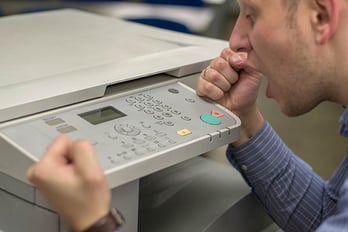 While many businesses are beginning to reopen in some form and employees are venturing back to the office, one goal is clear - getting back to work.
While many businesses are beginning to reopen in some form and employees are venturing back to the office, one goal is clear - getting back to work.
There is no piece of technology in your office that is used more often by all employees than your copier. When a copier sits idle for a period of time, there may be some initial issues in operations like paper jams, low quality prints and the like. But there are ways to try and rectify these issues. Here are a few pointers to get your copier running full speed ahead.
- Clean your copier. It is important to make sure that there is minimal dust on the copier, in particular the document feeder. The document feeder is essentially an opening for dirt and dust to get into the working mechanisms of your device. And because it's on top of your copier, it's likely collected the most dust during the shutdown. Next, use a can of compressed air to make sure all of the cracks and crevices of the document feeder are free of dust and debris. There are lots of small areas where your hand won't be able to get to. Make sure you blow the dust away from the opening of your equipment. Finally, wipe down your slit glass and make sure it is free of lint, debris and marks. If not, the residue you leave behind could show up when making scans and copies.
- Swap out your old paper. Seems wasteful to toss out perfectly good paper, right? Well, paper that has been sitting in your device for the last three months has been subjected to moisture from your office environment. You may have turned off any HVAC, so air hasn't been circulating like it would normally. Paper is porous surface that will absorb moisture from the air, and this can cause the dreaded paper jams. Tossing out the old paper sitting in your device is the best option to avoid jamming, but maybe you're on a tight budget and not wanting to toss a whole bunch of good paper. Try this - remove the paper from each tray, one tray at a time, and fan the paper out several times. This lets air get in between the sheets of paper and helps it to dry out a bit, which helps it from sticking together and causing jams. The fanning method isn't 100% effective, but it is better than doing nothing at all.
- Run your device. Just like when a car sits for too long, things tend to settle, so you need to warm it up. Your copier needs a little warming up. Take a few minutes and print something. Don't print just one page - make it something lengthy. By allowing the copier to warm up you
- dry up any humidity that is trapped in the device
- airflow and heat will get rid of any dust that has settled into your device's inner workings
- make sure the rollers are operating smoothly and
- warm up the toner so everything prints evenly
- Do a color calibration. If you're using a color device, take a few minutes to run the color calibration function. This will ensure that your device is printing color correctly, as you want it to appear. To run a color calibration, you'll likely have to go to the settings area of your device, login as an administrator and then select auto color calibration from a menu. The menu options differ on devices, but should be easy to find. Once you select auto color calibration, a test patch page will print out. Take that test patch page and place it on your device's glass and hit start. The machine does the rest!
So before you start printing out your next manuscript or making copies of your employee handbooks, take a few minutes to follow these easy tips to get your equipment back up and running. If you still are having issues with your device, our service department is just a phone call or email away. You can reach our Smart Connect Team to place a service call at globalsupport@fraser-ais.com.
To keep your devices clean and safe during the pandemic, check out our blog post on Cleaning Your Copiers to Stay Safe During COVID-19. Here you'll find instructions from our manufacturer partners at Sharp and Canon on how to safely clean your devices.
